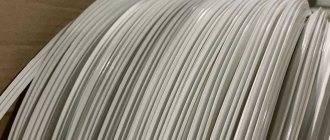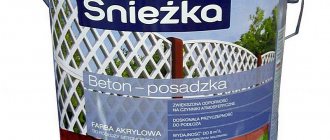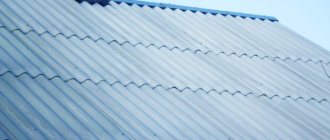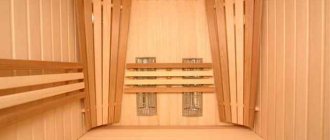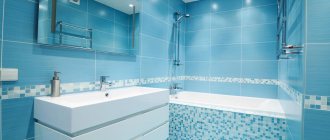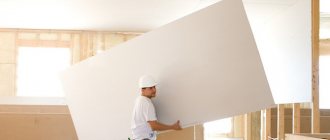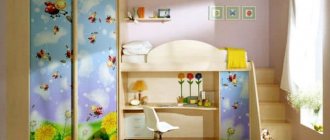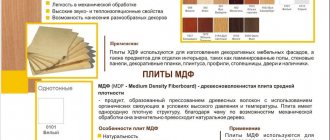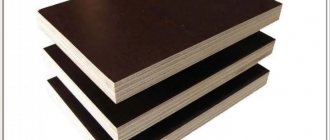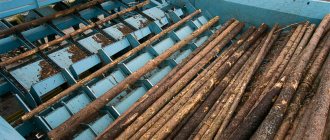During construction and during finishing work, it is often necessary to create a coating with improved properties - even, moderately durable. Chipboard (chipboard) has the necessary characteristics. The sheets are made from wood, but the base is not solid wood, but shavings. The slabs are susceptible to moisture, but this disadvantage is outweighed by their advantages. When choosing, you should consider different options for materials; they differ in appearance, properties, and therefore are used under different conditions.
Features of the material, history of appearance
Previously, the issue of recycling wood chips obtained during production for various purposes often arose. It was solved thanks to the appearance of slabs made from this raw material. Wood-based products first began to be used in the thirties of the last century. They were used for commercial purposes later - in the 40-50s. XX century Since then, the material has been used more and more often, and annual production has increased several times.
Raw materials: chipboard
Chipboard is a type of board made from shredded wood. They got their name due to the type of raw material that underlies them (wood shavings). Particles of different sizes are used, they are held together with a binder of non-mineral origin (synthetic glue, often based on phenol-formaldehyde resins). This feature limits the scope of application. The material contains a certain amount of toxic components, their dose is minimal, it is regulated by standards, and therefore the sheets are not prohibited. They are often used, including in the production of various pieces of furniture, and when performing finishing work.
What is laminated chipboard
The abbreviation LDSP refers to laminated chipboard or chipboard. Chipboard is made from wood processing waste using a special technology. First, all large residues are crushed to the state of shavings and sawdust, and then by hot pressing with the addition of a binder polymer composition they take the form of sheets of a certain thickness and shape. Next, the slabs are cut to standard sizes.
We figured out what chipboard is. The chipboard sheet is essentially rough; it does not have a decorative coating. It is used where a beautiful appearance is not required. But laminated chipboard is an improved chipboard. Melamine film is used as a coating, sometimes in addition to it varnish is used. Only high-quality boards are laminated, so that they can then be immediately used in the manufacture of furniture or as a facing material.
Advantages of laminated chipboard
Thanks to its protective film, in addition to its attractive appearance, laminated chipboard has a number of other advantages:
- wide range of colors and textures;
- strength;
- resistance to mechanical damage;
- high rates of heat and sound insulation;
- easy to restore original appearance after damage;
- immunity to bacteria and fungi;
- durability in use;
- ease of processing;
- no further painting required;
- efficiency.
Flaws
The use of laminated chipboard is limited in some areas of the furniture industry for several reasons:
- absorbs moisture and becomes deformed;
- does not have resistance to high temperatures;
- You cannot carry out deep milling and create curved contours;
- fragility during deep and long-term processing;
- harm to health and low environmental friendliness due to the use of hazardous formaldehyde resins in the manufacturing process.
Chipboard varieties
Depending on the quality, the appearance of particle boards can have the following individual parameters:
- Grade 1 - the surface of such a slab does not have any foreign inclusions, is smooth, and only a few and very small defects are allowed in it. It is formed mainly from waste of one type of wood and is always decorated on both sides;
- Grade 2 – has a rougher surface due to small scratches, chips and peelings of the composite; their lining is not carried out in all cases;
- Grade 3 is the lowest quality slab, most often a manufacturing defect. May differ in the presence of multiple defects, cracks, deep scratches. Such chipboards are usually used in auxiliary construction.
Chipboard classes and marking interpretation
The emission class is the most important safety characteristic of chipboard. It indicates the amount of harmful substance present in the slabs - formaldehyde resins, which negatively affect human health. That is why the content of this substance is regulated by state standards. Now laminated chipboards in Russia are produced according to GOST 10632-2014.
Based on the amount of formaldehyde released, chipboards are divided into the following emission classes:
- E 1 – the safest for humans. Contains 10 mg of formaldehyde resins per 100 g of sawdust. Slabs with such emissions are used in the manufacture of children's rooms, construction and renovation of residential premises;
- E 2 – may be harmful to human health. Contains 30 mg of formaldehyde per 100 g of wood. They are not suitable for renovation and construction of residential premises, and in European countries manufacturers have already stopped producing chipboards of this class;
- Super E or E 0.5 - contain half as much formaldehyde compared to class E 1. They have a high cost and are produced in European countries.
Standard sizes
When ordering one or another version of the panels, it is important for a specialist working with chipboard to calculate in advance what loads the slab can withstand. To do this, it must have a certain ratio of thickness, size and rigidity. All sizes of chipboard do not differ from laminated chipboard and are reflected in the standards regulated by GOST 33289-2013. Based on these dimensions, a person can choose the most suitable format for himself.
Linear dimensions for laminated chipboard:
- The length has nineteen sizes, the difference of which varies from 1830 to 5680 mm.
- The width comes in nine sizes: from 1220 to 2500 mm.
The most in demand are standard sizes of 2750x1830 mm, 2800x2070 mm laminated chipboard sheets, as well as slabs with dimensions of 16 mm 3500x1750 mm, which are produced by leading manufacturers. But the standard also allows for the manufacture of products with other parameters, depending on market demand and the production base. In Russia, the standard dimensions have become 2500x1850, 2620x1830, 3060x1830, 3060x1220 and small chipboard sheet sizes of 500x500 or 600x500 mm.
Thickness and area of application
The thickness of laminated chipboard is determined by the state standard only to a minimum value. It should be no thinner than 3 mm. Further, this parameter can be any multiple of one millimeter. Most manufacturers produce slabs with thicknesses from 8 to 38 mm. Among them, panels with a thickness of 5, 7, 13, 17 mm, as well as those exceeding the maximum thickness of 40, 50 and even 100 mm, are mainly made to order individually.
The thickness of the panels is selected depending on the type of furniture products, their operating conditions and load. The thicker the slab, the greater the load it can withstand. However, thin panels are more flexible, therefore, they do not break as quickly as thick ones. Thickness is also decisive for the rigidity of the slabs. Based on these features, the scope of application of laminated chipboard for furniture has been formed:
- thin sheets (up to 10 mm) are used for cladding walls, for furniture decoration and as shelves and drawers;
- medium sheets (12 - 20 mm) are considered the most versatile and are used for laying floors, creating partitions and furniture parts under not very high loads. According to statistics from construction markets, laminated chipboard sheets with a size of 16 mm are most often used for home repairs and in the manufacture of furniture;
- A thick sheet of laminated chipboard (over 25 mm) can withstand high loads and therefore they are used to make support elements in kitchen furniture, shelves for heavy objects and countertops.
Chipboard weight
How much a slab weighs is determined not only by its size, but also by other factors: compaction density, humidity, as well as the quality and type of raw materials. All these reasons lead to the fact that slabs of the same shape and size can weigh differently, which means that the difference will be in mass and density (specific gravity). GOST allows density from 550 to 850 kg/m3. For example, the weight of a chipboard sheet with a square meter area and a thickness of 16 mm at a density of 550 kg/m3 will be 5.5 kg, and at 820 kg/m3 – 8.2 kg. It is the density that determines how the slab can be used.
Stages and features of production
To make chipboard, raw materials of different sizes and types are used:
- chips: they are produced on rotary-type machines;
- chips are the result of the operation of special equipment (for example, a chipper or a knife shaft).
To produce particle boards, you need raw materials whose particles correspond to standard parameters with deviations (to a lesser extent from the specified values):
- thickness – 0.5 mm;
- width – 5 mm;
- length – 40 mm.
The quality of the finishing material depends more on the thickness of the chips. It is better if it is as thin as possible. When specially harvested wood is used, rather than production waste, round timber or large boards will be needed. After preparation (removing the bark, dividing into smaller pieces, soaking), the material is crushed. This is how the raw materials are obtained, which are used to produce the top layer of the slab. Inside there are large chips, they are compressed, but in the section you can see the difference between the structure of the layers. To improve the quality of the raw material, it is additionally dried and sifted, then re-grinded.
Stages of plate production:
- All types of raw materials (for internal and external layers) require drying. This is done after calibrating it in size.
- The chips fall into the mixers, which are constantly rotating. Here it is mixed with binding components. It is important that every particle is coated with resin. This result is achieved by blowing a stream of air along with drops of the binder component. The resin envelops the chips.
- The mass falls on the conveyor belt, where future sheets are formed - layers of material of different thicknesses are created.
- The layer is cut into slabs and compacted using the vibrocompression method at a temperature of +180°...+220°C.
- Heating can increase the strength of the boards, which is achieved due to the effect of temperatures on the resin.
- Products are cooled. Moreover, to obtain materials with the desired properties, a gradual decrease in the temperature of the plates is required - in a natural way.
Standard sizes
To purchase quality material, you need to know the standard parameters of the slabs. Today, slabs are produced with general parameters and additional (possible) sizes. The presence of different parameters provides a person with a wide range from which he can choose the appropriate option.
Chipboard
When choosing a material for construction or repair, you need to know the standard parameters of the boards.
According to GOST 10632-2014, the overall dimensions of the slab in length, width and thickness can be selected within the following limits:
- from 1800 to 5680 mm;
- from 1200 to 2500 mm;
- from 1 to 28 mm.
Sheet sizes may vary slightly.
Standard sheet parameters:
- 2750 x 1830 x 15 mm;
- 2440 x 1830 x 16 mm;
- 2620 x 1830 x 16 mm;
- 2440 x 1200 x 16 mm.
You can also choose chipboard in other sizes. More details in the table:
| Thickness (mm) | Length (mm) | Width (mm) |
| 10 | 2750 | 1830 |
| 16 | 2750 2440 3500 | 1830 1830 1750 |
| 18 | 2750 2440 2800 | 1830 1830 2070 |
| 22 | 2440 | 1830 |
| 25 | 2440 | 1830 |
| 28 | 2800 3050 | 1830 1830 |
It is important to know that in high-quality products, deviations from the norms should not exceed 0.3 mm in thickness and 5 mm in length and width.
Laminated chipboard
The quality of laminated boards is regulated by GOST.
The main dimensions are within:
- from 1830 to 5680 mm;
- from 1200 to 2500 mm;
- from 3 to 38 mm.
Depending on the capabilities of the equipment, each manufacturer produces several basic sizes of chipboard.
The most popular of them:
- 2800 x 2620 mm;
- 2800 x 2070 mm;
- 2620 x 1830 mm;
- 2500 x 1830 mm.
Overview of types of chipboard
In its original form, chipboard is used without additives, auxiliary layers, or structural elements. However, it is often necessary to use improved material. This led to the emergence of different types of slabs:
- laminated (laminated chipboard): coatings of several varieties are tried on (paper-resin film, plastic and paper-laminated material), which can affect the properties of the product;
laminated chipboard
- fire-resistant boards: contain fire retardants, making the material more resistant to high temperatures;
- moisture-resistant: they contain urea-melamine resins, hydrophobic polymer additives; boards of this type can be distinguished by their greenish tint;
Moisture-resistant chipboard
- veneered: similar to solid wood, but only externally, because the outside is covered with veneer, due to which the material imitates natural wood;
- tongue-and-groove (chipboard Quick Deck): they differ in the configuration of the cuts; grooves and tenons are formed here, making it possible to assemble a seamless durable coating.
Tongue-and-groove chipboards.
Separately, perforated boards should be noted. They are produced by extrusion. This type of material is used primarily in the production of door panels (laid inside), so it is not found on the open market. Features of such plates:
- presence of through holes;
- high sound insulation qualities;
- increased thermal insulation;
- resistance to deformation due to exposure to temperature changes.
The narrow scope of application of such chipboard is also due to its insufficiently high strength. Veneered material differs from this variety. For the coating, veneers of different species are used, but more often - oak, ash, which improves the quality of the slab, it becomes stronger, and better resists mechanical loads. Veneer, like lamination, gives the material decorative qualities. At the same time, wear resistance increases. At the same time, moisture resistance increases.
Important! Even if the material is covered with veneer or polymer film, this does not make it waterproof. Such slabs withstand exposure to a humid environment better. However, prolonged contact with water is not recommended. The material remains hygroscopic, depending on the type, it swells by 5-30%, which means it is deformed in such an environment.
Manufacturability of chipboard
In terms of convenience and economy of use, chipboard is very much superior to wood. This parameter does not have a numerical expression, but several facts can be cited to illustrate the advantage of chipboard in this regard.
Minimum operations in the manufacture of products
In order to make furniture or other structures from chipboard, you need to perform several basic steps:
- cutting the sheet into parts of the required sizes;
- drilling holes and sockets for fasteners and accessories;
- installation of accessories and assembly.
In many cases, drilling as a separate operation is not available. When using a laminated board, painting with accompanying preparation is not required; only edge trimming is required, which is done on special machines and does not require much effort.
The most difficult operation in furniture making is cutting out parts of complex curved shapes. But the number of such parts is usually small.
Let's compare the above with the actions necessary for a wood product:
- sawing;
- planing;
- fine planing (thicknesser);
- cutting into parts;
- milling, often necessary to connect parts;
- sealing defects;
- grinding;
- painting.
If large parts are required, then the operations of gluing a board from slats or assembling a large part from small ones are added, since the width of wooden boards usually does not exceed 300 mm. Countertops and cabinet doors are made using this method. And this is just the preparation of the parts that need to be combined into a product!
Easy assembly operations
When installing fittings on chipboard parts, drilling for fasteners is often not required. For wood it is required more often, especially for hardwoods. Drilling into chipboard is easier than wood. A slab made from chips is less demanding on the accuracy of installation of fasteners and accessories. All this reduces labor costs in production.
Product stability
Chipboard, unlike wood, does not change size with fluctuations in humidity. Parts made from it will not crack in the summer heat, they will not warp, there will not be an extra gap or a strip of unpainted surface anywhere, as happens with wooden doors. Under normal use, a chipboard product remains unchanged for many years.
Classification
One of the first parameters that people pay attention to is the type of surface treatment. There are 2 options: sanded and unpolished slabs. They differ in the quality of the coating, which determines the area of application of the material. In addition, the slabs are distinguished by structure:
- ordinary (designated by the first letter – O);
- fine-textured (M).
The second option is used in the production of laminated boards. This is due to the fact that the film adheres better to the surface of such a product.
Surface quality
Slabs of different types are produced, differing in the number of defects:
- 1st grade – without changes in the structure of the material, defects;
- Grade 2 – a certain amount of damage is acceptable (regulated by regulatory documentation).
Due to average strength and moisture resistance, chipboard with more significant defects is not used, since it will not perform its main functions. The service life of the material will be significantly reduced.
Emission class
There are types of stoves that differ in the degree of danger to human health. They contain varying amounts of toxic components (in particular formaldehyde):
- E0.5;
- E1;
- E2.
Is chipboard harmful?
If you need to use the material indoors, only the first two options are considered. The concentration of formaldehyde in the structure of the binder component and when released into the surrounding space is minimal and is considered acceptable. However, the rule here is: the less, the better, so option E0.5 is preferable.
Strength level
There are types:
- P1 – general purpose;
- P2 – products intended for the manufacture of furniture and finishing work indoors.
The second option is more durable, so the scope of application of the slabs of this group is wider. P1 products are more often used for rough finishing, temporary structures or as auxiliary material. The strength of chipboard varies: 550-750 cubic meters. m. At the same time, the range of density values is also different: 0.5-1.0 g/cubic. see. Tensile strength is also taken into account:
- when bending – 10-25 MPa;
- when stretching - 0.2-03.5 MPa.
What to look for when choosing
Today, the shelves of construction supermarkets contain a huge selection of high-quality chipboards, but there are also fakes.
How to distinguish high-quality material from low-quality one:
- Chip quality. Low-quality lumber is used in production, but if the chips were selected correctly, the quality of the slab will be high.
- Petal-shaped shavings. The cross section of the chips should be as close to square as possible. The chip particles must have standard parameters. If the rules are violated, the slabs will not be resistant to mechanical damage, and may become deformed when bent.
- Smooth surface. If, when choosing, you find potholes or cracks, bumps and roughness on the material, you need to look for another option and refuse the purchase. The presence of defects on the surface of the material indicates that violations were committed during the manufacturing process. Such a slab will not be durable.
- The strong smell of formaldehyde is a sign of poor quality. Formaldehyde is a poisonous gas that can pose a risk to human health. Therefore, before purchasing a building material, you need to make sure that it is odorless. It is important to do this indoors, because in a cold room the evaporation rate decreases.
Experts recommend purchasing laminated chipboards made using European technologies. Unlike domestic and American manufacturers, there is much less formaldehyde resin in this material, which is safe for humans and the environment.
Advantages and disadvantages
First, it is necessary to note the positive qualities of the material:
- the products are resistant to deformation due to long-term use (the slabs do not crack or dry out);
- the material is not susceptible to fungal development;
- does not attract insects;
- Chipboard is not subject to flare-up, does not ignite well, and the combustion process is not intense;
- you can make a coating no worse than a monolithic one - the slabs fit together and form an ideal coating without cracks;
- The products cost much less than other wood materials.
Chipboard also has disadvantages:
- low thermal insulation properties, such products are used as auxiliary;
- the material is still flammable, although its combustion rate is low;
- the plates are hygroscopic, it is not recommended to use them in damp rooms;
- Do not screw in self-tapping screws from the end side, this reduces the strength of the product;
- the composition contains toxic components, the material does not belong to environmentally friendly coatings;
- low bending strength.
Rules for painting chipboard
Before painting the slab, you need to decide on the paint.
The following types of paints are used to paint chipboard:
- Acrylic - must be applied to the prepared surface. Due to its water base, it is quickly absorbed.
- Latex - protects against moisture, but their cost is very high and they are difficult to remove.
- Alkyd - can be applied without a primer, but in this case it is worth stocking up on a large amount of paint.
- Stain - used for impregnation and creating a certain texture. Excellent for laminated chipboards.
- Varnish - a colorless version is used to protect the surface.
- Spray paint is suitable only for decoration, as it is not capable of painting a large surface.
Painting must begin with a primer. To do this, acrylic compounds are used, with which several layers of material are impregnated. After applying the paint, you must wait until it dries completely.
Coloring stages:
- The paint must be applied with a roller or spray gun. Hard-to-reach places are painted with a brush. If painting is carried out without priming, you can thin the paint a little.
- The coloring composition must be evenly distributed over the surface in one direction. Apply 2 to 5 times. Spraying can be used, but this is a more complex process.
- After the last coating has completely dried, varnish can be applied as additional protection.
Application area
The main direction of use of particle boards is furniture production. Certain types of chipboard are used in construction and interior finishing. Problems that can be solved using this material:
- fencing at construction sites;
- formwork for the foundation (dismantled);
- building structures (minor elements);
- interior doors;
- a substrate for the subfloor that prevents abrasion of the main structural elements;
- ramps;
- panels (for finishing walls, ceilings);
- floor finishing material;
- insert stands;
- roof structural element (cladding);
- storage container.
When it is planned to install temporary structures or permanent structural elements, waterproofing (film materials) is used. Chipboard is not used for finishing facades. The exception is when good protection from water is simultaneously created and an effective ventilation system for the structure is installed.
Chipboard varieties
Wood-based sheets are divided into three grades. Each of them has individual characteristics and indicators.
Chipboard varieties and their characteristics:
- the first is a flat surface without the presence of tubercles;
- the second - may have small scratches, peeling of the composite or pimples;
- third - they are characterized by uneven thickness, deep delaminations, cracks and scratches. In other words, this is a marriage.
Subtleties of using chipboard in furniture production
Chipboards (the laminated variety) are often found in the form of furniture walls, shelves, countertops, facades (inexpensive items), and frames. The advantage of chipboard compared to natural wood in such production is that there is no need to additionally process the material, sand it, or paint it. It is enough to determine the dimensions of the structural elements, cut them, and assemble the product using standard fasteners.
However, there is a difficulty when working with laminated chipboards - edge processing. To protect it, an impenetrable material is glued at the production stage, which serves as a decorative and protective element. It is difficult to use such film on your own.
Gradually, laminated chipboard, like chipboard, is replacing MDF - this is another type of particle board, but it is more expensive. However, such plates have improved characteristics.
What is chipboard
Chipboard is a sheet material obtained by pressing from small wood shavings, which are held together with glue. The idea of creating such a composite appeared in 1918. Initially, it was proposed to make a slab from shavings with double-sided plywood lining. In subsequent decades, manufacturing technology was refined and improved. The first commercial chipboard production plant opened in 1941 in Bremen, Germany. Widespread use of wood waste boards began after the end of the war.
Interest in the new material is due to several reasons:
- ease of obtaining large-sized parts;
- stability of shape and size;
- using waste as raw material instead of scarce wood.
Thanks to the mass production of chipboard, the amount of irretrievable wood loss during timber harvesting and processing was reduced from 60 to 10%, and the construction and furniture industry received a convenient, technologically advanced and cheap material.
Review of manufacturers
Products of reliable quality, with a long service life and the required safety class can only be manufactured by those manufacturers who comply with all technical regulations and have the appropriate quality certificates. These are mainly large manufacturing companies. There are several such companies on our market.
Egger
This is an Austrian company, which is now the world leader in chipboard production. The raw materials for the boards are coniferous trees. The laminated products of this company have a European safety class, many colors and textures. For example, Egger chipboards come in single-color glossy or matte versions and can have more than a hundred wood-like shades.
Kronospan
Another manufacturer of laminated boards from Austria, which has been on the market for more than a century. What distinguishes the products of the brand bearing this name is their high environmental friendliness, good moisture resistance and increased wear resistance, which makes it possible to use its properties as furniture for the kitchen and bathroom. Kronospan laminated chipboard also stands out from others due to its very diverse color options: from monochromatic to fancy. The texture almost completely imitates natural wood.
Lamartie
The manufacturing company is a plywood plant in the city of Syktyvkar. Thanks to the automation of production processes, its products have a high safety class and good technical parameters. All textures and colors of the manufacturer are on the same level with foreign manufacturers.
Reasons for the popularity of chipboard
The chipboard production technology is quite simple: using a special adhesive composition, natural wood shavings are tightly connected to each other. Low-value softwood waste is used as the main “ingredient”, so such production is very justified from an environmental point of view.
You can find out which furniture is better made from chipboard or MDF in this article.
Often such designs are limited in width to two thin sheets of laminated film. The thickness of the formed layer of the slab can be 8 – 38 mm. The most popular are chipboards with a width of 16-18 mm.
Advantages of DPS:
- Ease of processing.
- Low cost.
- Light weight.
- Good strength.
- Uniformity of structure.
- Large selection of chipboard colors.
All these indicators make the slabs very popular in various fields of construction.
Such plates also have disadvantages. They mainly concern the quality of the binders used. If the excess of formaldehyde resins is greater than the average, the use of such materials in residential premises is highly doubtful. To avoid harmful effects on the body, slabs should be selected according to their safety class, without using chipboards of inappropriate parameters.
Here you can find out what is better for a kitchen: MDF or chipboard.
The moisture resistance of chipboard is also a significant disadvantage in the reputation of the material. To avoid the destructive effects of moisture, sometimes a special layer of film is applied to the surface of the slab; the result is so-called laminated chipboard, which is much better than usual in terms of performance parameters and even appearance, which is also important.
Fiberboard or chipboard, which is better for the floor, can be found out in this article.
Laminated chipboard sheet sizes
LDSP is a laminated board (chipboard)
- made on the basis of top quality chipboard, covered with facing material, and is not afraid of various mechanical influences and moisture. Beautiful appearance, a wide variety of colors (about two hundred types), has good consumer properties and quality.
For cladding, use a polished (W) laminated chipboard, grade (P-A), first grade (1), fine-textured surface (M), formaldehyde emission (E-1). (B) - moisture resistant. Methods of cladding slabs: - paper-resin films; - laminated paper plastics; - polymer films; -natural (peeled or planed) veneer.
Total formaldehyde emission class:
-E1-in 100g of dry board there is less than 10 mg of pure formaldehyde; -E2-in 100g of dry slab more than 10 mg but less than 30 mg of pure formaldehyde;
Regulations:
-GOST 10632-89-Particle boards; -TU13-0260215-02-87-Particle boards, lined with films based on thermosetting polymers. Technical conditions.
Types of sheets used in markets. Dimensions are given in millimeters.
AхB (3500х1750) S = 16 AхB (2440х1830) S = 8, 16, 18, 22, 25 AхB (2500х1830) S = 16, 25 AхB (2620х1830) S = 8, 10, 12, 16, 18, 22, 25 , 28 AxB (2750x1830) S = 10, 16, 18 AxB (2800x2070) S = 8, 10, 12, 16, 18, 22, 25, 28 AxB (2800x2620) S = 8, 10, 12, 16, 18, 22, 25, 28
P – material density is 630...740 kg/m3. Knowing the density of the material, you can easily calculate its weight. M = A*B*S*P
Used: - for the manufacture of cabinet furniture (with S = 16...18mm - dressing rooms, cabinets; with S = 12...25mm - tabletops, other elements subject to high loads; with S = 8...10mm - filling in framed facades, sliding doors for cabinets , other elements subjecting low loads); -for the manufacture of furniture (upholstered); -for the production of elements (construction); - for the manufacture of carriages; - for the manufacture of containers.
The slabs are cut on format cutting machines. It will be very difficult to cut the slab correctly yourself, without work experience, skills, the necessary equipment and the necessary devices. It is better to contact the relevant organizations with this question (problem), with a complete list of measured details. To make furniture you will need a set of parts of the required sizes and types (types). Using a cutting map, you can lay out all the parts on the standard sizes of the used laminated chipboard sheet. Optimal layout of parts will reduce the size of the leftovers that will result from cutting. You can make a cutting map yourself using the Cutting 3 program. The program is designed for cutting material (optimal) into rectangular or linear parts. It takes up little disk space, has a simple interface, and it won’t be difficult to figure it out on your own. The main advantage of cutting is that we see the entire amount of material from which the furniture is assembled.
After cutting the material into parts, we will need to seal the ends of the chipboard.
But in addition to the listed advantages, when choosing a material, it is necessary to take into account significant disadvantages: - screws and nails do not hold well, using them several times; - environmentally unsafe for human health (releases formaldehyde).
CLASS (E2) – PROHIBITED IN THE PRODUCTION AND MANUFACTURING OF FURNITURE
The right choice is best to leave the “Super E” (super safe) class behind the stove.
Production
In the photo you can see that chipboard is a board made from compressed waste obtained from wood processing and sawmilling.
Most often this is slabs, slats, wood chips, sawdust or shavings.
To obtain high-quality material, special requirements are placed on raw materials:
- The raw materials cannot be very small; certain sizes are achieved as a result of processing on rotary machines, crushers and mills.
- The sawdust must be thoroughly dried; for this, a temperature of 900-1000 0 C is maintained in the dryer furnace.
- The chips must have the required shape so that the surface of the slab meets certain requirements.
The dimensions of the chipboard determine the properties
Naturally, the operational characteristics of the chipboard, in other words, the properties, directly depend on the geometric parameters of the sheets.
The thickness of the slab is related to the strength of the slab, not only during the operation of manufactured products, but also during its transportation. The thicker the chipboard, the greater the load the slab can withstand. Accordingly, the thickest sheets are used for particularly loaded products.
At the same time, as the slab’s resistance to deformation increases, its flexibility decreases. Thin sheets of chipboard (up to 10 mm) are relatively flexible - this is evident even under light loads. But thick ones (25 mm or more) are characterized by low flexibility. Under high loads, they will crack and break faster than they will bend.
The thickness of the chipboard sheets also affects the hardness of the material. As thickness increases, hardness increases.
